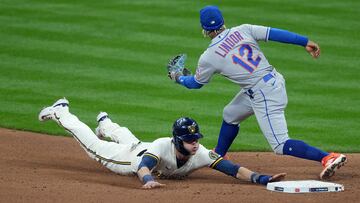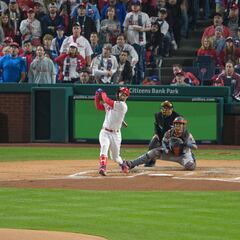How have the new MLB rules changed baseball so far? Stolen bases, batting, game duration?
As the numbers clearly show, MLB’s changes to the rules are garnering the exact effect that they hoped for and with that, baseball fans are indeed happy.


With the 2023 MLB regular season now underway, fans have already been talking about the effect of some of the league’s rule changes. Yet, what are they and what has their impact on the game been since their implementation?
What are the key rule changes in MLB?
Before we get to the actual rule changes, it’s also worth noting that MLB introduced a new schedule format in 2023. What that means, is that every team will play every other team at least once during the season. This of course is in keeping with the league’s attempt to increase the entertainment value of the sport. To that end, it makes sense that the primary goal of the new rules that they’ve implemented is to increase both the pace of play and the level of drama in the game. Here’s how the three central rule changes look:
- Pitch timer: 15 seconds with the bases empty and 20 seconds with runners on base
- Limit on extreme shifts: Two infielders on each side of second base with both feet on the dirt or infield grass.
- Larger bases: base size increased to 18 inches x 18 inches from 15 inches x 15 inches.
Needless to say, these alterations are specifically geared towards ramping up the number of hits we’ll see, the number of bases stolen and in general creating a scenario in which we will hopefully see more athleticism on show. These changes come in response to growing criticism of the length of games - they’ve got longer and longer - as well as the rise in walks and strikeouts.
How has the Pitch Timer changed games?
Off the bat, it’s definitely worth noting that games in 2023 are shorter by a noticeable amount. Across the first few days of the 2022 season, the average game clocked three hours and eight minutes. Here and now, we’ve seen an average of two hours and 38 minutes. You do the math. Of course there has been significant push back from some such as Bryce Harper who made his position crystal clear, but such is the way when facing any change to routine i.e., there will be those in favor and those against.
With the introduction of the pitch timer, the pace of America's favorite pastime has changed drastically.
— MLB Now (@MLBNow) March 31, 2023
BK digs in on how this impacts the game on multiple levels. #MLBNow pic.twitter.com/G7Jpk7uJpT
What about extreme shifts?
Though many believed that the limitation of extreme shifts would have a negative effect on the game, we’ve already seen that to be quite the opposite. To be quite frank, we’ve seen an almost instantaneous jump in the number of hits and it’s clearly observable in the stats. Across the initial days of last season, we saw a batting average of .230 and it’s now up to .246. That’s also the case with left-handed batters in case you’re wondering. This year’s average sees them hitting .254 as opposed to last year’s .230.
MLB: extreme pull hitters are back because we banned the shift!
— Eric Mintzer (@MintSports) March 22, 2023
Daniel Vogelbach:#LGM pic.twitter.com/lFQhJGSfVm
“We are extremely pleased with the early returns,” Commissioner Rob Manfred said Monday. “Fan reaction has been positive to the brisker pace with more action. And players have made a great adjustment to the changes.”
So, bases are bigger. How does that work?
Related stories
Base stealing is perhaps one of the most exciting parts of baseball, the high-risk endeavor is all about guile, speed and timing, which is precisely why increasing the size of the bases only adds to the fun. To be clear, the increase in base size has closed the distance between bags by 4 1/2 inches. Now, while that may seem like a change that’s hardly worth the fuss it’s received, the fact that the average stolen bases per game is up from 0.6 last year, to 1.4 this year says something.
Great points with no more shifts and bigger bases and the pitch clock - changes will be amazing in #MLB #JohnSmoltz is great to listen to on #TheCartonShow pic.twitter.com/babBSFa9Ye
— Connie Carberg (@ConnieScouts) March 31, 2023
“I think it’s in everybody’s mind, like, whoa, I can run more. And the more you run and you’re successful with it, the more you’re going to run,” Los Angeles Angels manager Phil Nevin said.

